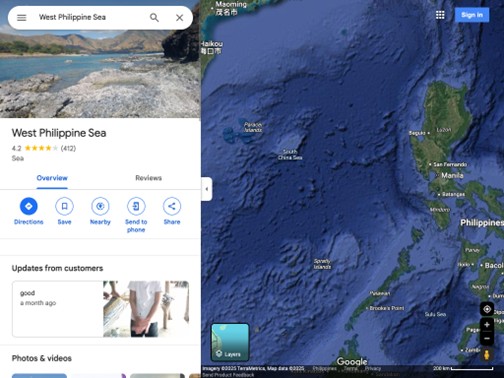Have you ever looked around the world in Google Maps or Google Earth recently? If you explored North America, you might have noticed this strange label for the body of water south of the United States and east of Mexico: “Gulf of Mexico (Gulf of America)”.

Google recently announced this change in their Maps service stating that for users in the United States, the body of water will be labeled “Gulf of America” while people visiting from Mexico will see “Gulf of Mexico” instead. Meanwhile, the rest of the world gets both names: “Gulf of Mexico (Gulf of America)”. This change stems from U.S. President Donald Trump’s Executive Order 14172, “Restoring Names That Honor American Greatness”—one of the dizzying flurry of orders Trump released on the first day of his second term.
Other online map providers like Apple Maps have followed suit. On the other hand, MapQuest, the first online map website, still displays the longstanding name, Gulf of Mexico, which is the body of water’s official international name according to the International Hydrographic Organization (IHO), and has been in use in world maps since the 16th century. The name even predates the existence of the United States for over 200 years.
While Trump cannot force the whole world to follow his unilateral orders, his presidential decree applies to the whole U.S. government and not to private companies and individuals. However, this hasn’t stopped the White House from punishing those who defy his will, including barring an Associated Press reporter from covering presidential events after AP stated that it will continue to use the “Gulf of Mexico” name in its reporting. AP’s reasoning is that the gulf is part of international waters and is shared with Mexico and Cuba so it will continue to cater to the needs of its international readers.
You might not know, but Google Maps displays different labels based on a user’s location. It has presented different political views of Earth for well over a decade such as displaying the occupied Ukrainian territory of Crimea as part of Russia for Russian visitors ever since Russia invaded the peninsula in 2014. This policy applies to many other disputed names and territories, such as the Indian state of Arunachal Pradesh, which Google Maps shows as part of China for Chinese users, or the Persian Gulf, which is named the Arabian Gulf for Iran’s neighbors across the gulf like Saudi Arabia and the United Arab Emirates. In many cases, Google is forced to do this because it needs to follow local government policies in order to provide services in a country.
The renaming of the Gulf of Mexico in Google Maps is apparently so unpopular that users had been spamming the website with prank reviews, prompting Google to turn off reviews for the gulf and removing many recent comments. Searching for the gulf in Google Maps and then switching to the “Reviews” tab currently shows the message, “Posting is currently turned off.”
Trump’s renaming parallels a similar move by the Philippine government. Former President Benigno Aquino III issued Administrative Order No. 29 in 2012 designating the maritime areas west of the Philippines as the “West Philippine Sea” which includes the disputed territories of Bajo de Masinloc (Scarborough Shoal) and the Kalayaan Group of Islands (Spratly Islands). This name was affirmed after President Ferdinand Marcos Jr. signed Republic Act No. 12064, also known as the Philippine Maritime Zones Act, last November.
But wait, why does “Gulf of America” show up on Google Maps, while the “West Philippine Sea” label doesn’t?
Sadly, it appears that the Philippines is not a significant-enough market in Google’s eyes that it will show the names of features that are preferred by the Philippine government. Hence, we get Second Thomas Shoal instead of Ayungin Shoal, and Thitu Island instead of Pag-asa Island. Maintaining various map viewpoints increases the maintenance and service costs of Google Maps so it stands to reason that Google would want to limit the number of custom labels it shows.

But fear not! Searching for “West Philippine Sea” in Google Maps still provides a result centered roughly in the center of the western exclusive economic zone of the Philippines. And unlike the Gulf of Mexico, you can still provide your reviews of the sea, such as this review by a Google Maps user from six years ago: “Picture perfect at any angle. Great location to bask in the sun, to swim or to simply pass the time away.”

UPDATE (April 15, 2025) — As noted by many Filipinos on social media, Google updated their Maps service to now prominently label the West Philippine Sea alongside the South China Sea without having to search for it like before. In a statement released by the Armed Forces of the Philippines, spokesperson Col. Francel Margareth Padilla said this “affirms international recognition of the country’s sovereign rights.”
When asked about this recent development, Lin Jian, the spokesperson for China’s foreign ministry, stated that the “[South China Sea] is broadly accepted by countries all around the world and by international organizations, including the UN.” In response to questions from Agence France-Presse reporters, Google clarified: “The West Philippine Sea has always been labeled on Google Maps. We recently made this label easier to see at additional zoom levels.”


